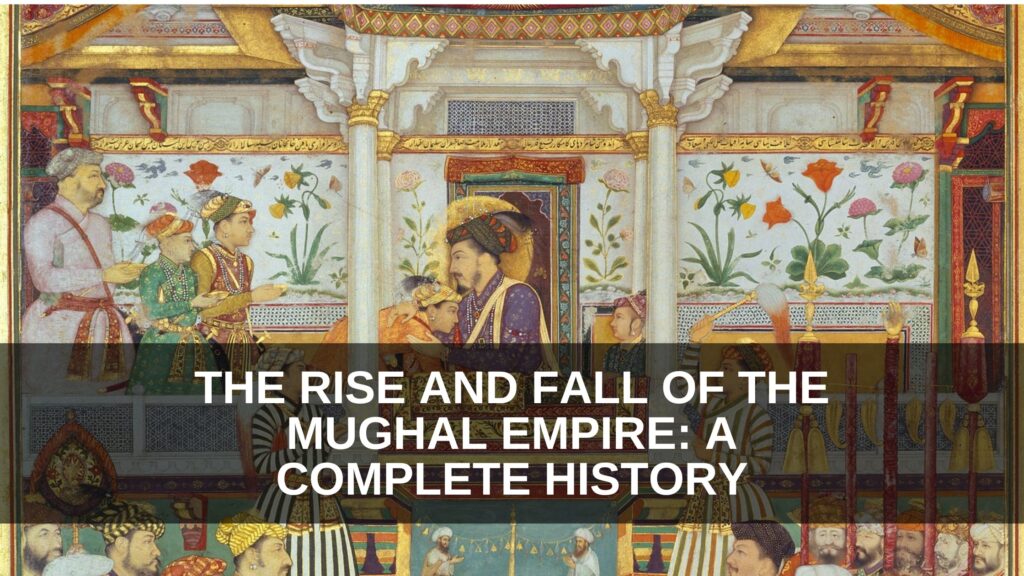The Mughal Empire was one of the most powerful and influential dynasties in Indian history. Founded by Babur, a descendant of the Turco-Mongol conqueror Timur, the empire flourished under his successors, reaching its peak during Aurangzeb’s rule.
However, internal conflicts and external pressures eventually led to its decline. This blog explores the origins, expansion, administration, and downfall of the Mughal Empire.
Foundation of the Mughal Empire: Babur (1526-1530)
Babur, a descendant of both Timur on his father’s side and Genghis Khan on his mother’s side, laid the foundation of the Mughal Empire. Initially ruling over a small kingdom in Fergana, he was forced out due to the rise of the Safavids. He seized Kabul in 1504 and later entered India through the Khyber Pass.
Download notes of The Portuguese in India
Major Battles of Babur:
- First Battle of Panipat (1526): Babur defeated Ibrahim Lodi with superior firepower and strategic warfare, capturing Delhi and Agra.
- Battle of Khanwa (1527): Babur defeated Rana Sanga of Mewar, consolidating his control over North India.
- Battle of Chanderi (1528): Babur defeated Medini Rai of Chanderi, further strengthening his empire.
- Battle of Ghagra (1529): Though not a decisive victory, Babur managed to weaken Afghan resistance in eastern India.
Babur’s Contributions:
- Introduced gunpowder and artillery warfare to India.
- Authored Tuzuk-i-Baburi, an autobiography written in Turkish.
- Integrated Kabul and Qandahar into the empire, enhancing trade and communication.
Humayun (1530-1540, 1555-1556)
After Babur’s death, his son Humayun faced numerous challenges. The Afghan chieftain Sher Shah Suri defeated him in two major battles:
- Battle of Chausa (1539) – Humayun was defeated and forced to flee.
- Battle of Kannauj (1540) – Sher Shah Suri overthrew Humayun, establishing the Sur Empire.
During his exile, Humayun sought refuge in Persia. With Persian assistance, he reclaimed Delhi in 1555 but died a year later after falling from a library staircase. His half-sister, Gulbadan Begum, wrote his biography, Humayunama.
Sher Shah Suri and the Sur Empire (1540-1555)
Sher Shah Suri, originally a small jagirdar, reorganized administration and introduced several reforms:
- Infrastructure: Restored the Grand Trunk Road and built sarais (inns) for travelers.
- Revenue System: Standardized currency with the silver Rupiya, which remained in use till British rule.
- Military: Introduced branding (dagh) and descriptive rolls (chehra) for soldiers.
- Art and Culture: Patronized Malik Muhammad Jayasi, who wrote Padmavat.
His sudden death led to the empire’s decline, allowing Humayun to reclaim the throne in 1555.
Akbar the Great (1556-1605): The Consolidator
At the young age of 13, Akbar ascended the throne under the regency of Bairam Khan. His reign saw extensive expansion and administrative innovations.
Major Military Campaigns:
- Defeated Hemu in the Second Battle of Panipat (1556), securing Mughal dominance.
- Conquered Gujarat (1572), Bengal (1574-75), and Kashmir (1586).
- Defeated Rajput resistance at Chittor (1568) and Ranthambore (1569).

Administrative and Religious Policies:
- Introduced the Mansabdari System, assigning ranks to officials.
- Implemented the Dahsala Revenue System, an improved land tax system.
- Promoted religious tolerance, abolishing Jizyah and pilgrimage tax.
- Established Din-i-Ilahi, an attempt at a syncretic religion.
- Built Ibadat Khana, a house of worship for religious debates.
Jahangir (1605-1627): The Patron of Arts
Jahangir, son of Akbar, continued his father’s policies but faced early rebellions.
Notable Events:
- Signed a peace treaty with Mewar.
- Allowed the British to establish a factory in Surat in 1615 after their naval victory over the Portuguese.
- Married Mehr-Un-Nisa (Nur Jahan), who became highly influential in court politics.
- Patronized Mughal painting, introducing portrait-style artworks.
Shah Jahan (1627-1658): The Architect King
Shah Jahan’s reign was marked by architectural marvels and economic prosperity.
Key Contributions:
- Constructed the Taj Mahal in memory of Mumtaz Mahal.
- Built the Red Fort and Jama Masjid in Delhi.
- Designed the Peacock Throne, a symbol of Mughal opulence.
His later years saw a war of succession among his sons, with Aurangzeb emerging victorious. Shah Jahan was imprisoned in the Agra Fort until his death in 1666.
Aurangzeb (1658-1707): The Last Great Mughal
Aurangzeb expanded the empire to its greatest territorial extent but faced severe challenges.
Military and Administrative Challenges:
- Engaged in prolonged wars with the Marathas, led by Shivaji and later Sambhaji.
- Struggled against the Ahoms in Assam (Battle of Saraighat, 1671).
- Ordered the execution of Guru Tegh Bahadur, leading to Sikh revolts.
- Enforced a strict Islamic policy, reintroducing Jizyah, which alienated non-Muslims.
Despite military successes, his policies weakened the empire, leading to financial exhaustion and increased rebellions.
Decline of the Mughal Empire (1707-1857)
After Aurangzeb’s death, weak successors and internal conflicts accelerated the empire’s decline.
Notable Events:
- Maratha resistance and expansion further weakened Mughal conThe Rise and Fall of the Mughal Empire: A Complete Historytrol.
- Nadir Shah’s invasion (1739) led to the looting of Delhi.
- British expansion: The East India Company gradually gained control, culminating in the 1857 Revolt, after which Bahadur Shah II, the last Mughal emperor, was exiled.
Download notes of The Bhakti Movement in North India
The Mughal Empire, once a dominant force, declined due to internal strife, economic decline, and external invasions. However, its legacy in administration, culture, and architecture continues to shape India’s historical and cultural landscape. From the grandeur of the Taj Mahal to the administrative foundations of modern governance, the Mughals left an indelible mark on Indian history.


